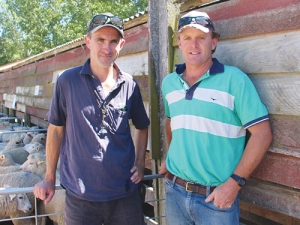Move over ham, here comes lamb
It’s official, lamb will take centre stage on Kiwi Christmas tables this year.
 The two farmers of the commercial properties which ran the trial Simon Wilson of Mt Hebert Station in Waipukurau (right) and manager of Taratahi’s Glenside Station Reuben McClean, Gladstone, say the trial confirmed for them that EBVs work.
The two farmers of the commercial properties which ran the trial Simon Wilson of Mt Hebert Station in Waipukurau (right) and manager of Taratahi’s Glenside Station Reuben McClean, Gladstone, say the trial confirmed for them that EBVs work.
A North Island trial comparing the value of lambs sired by low versus high genetic merit rams validates that using genetic data does pay off.
The "Data Drives Dollars" trial ran this season and aimed to find out if genetic selection information – specifically, EBVs (Estimated Breeding Values) – worked and if there was a financial gain from using rams with high genetic merit, or not.
It was a joint project between Massey University and red meat genetics company Focus Genetics, supported by Beef + Lamb New Zealand Genetics. The trail was run at Mt Hebert Station in Waipukurau and Taratahi's Glenside Station in Gladstone.
Trial results showed lambs sired by rams with higher genetic merit were 0.7kg heavier at weaning – which was worth an average of $1.69 more per lamb, compared to those with lower EBVs.
Focus Genetics sheep and deer programme manager Dr Richard Lee says the results show that EBVs work in delivering a significant production outcome – which increases dollars returned.
"For an average farmer, based on the schedule of $5.85 on 12 November 2015, this would have increased returns by over $2000 per farm per year, and if taken across the industry could add significantly to New Zealand export returns," Lee says. "We now have evidence here in New Zealand that proves rams with higher genetic merit do produce heavier lambs which increases farmer returns.
"It is now up to the industry and individual farmers to decide if the commercial advantage is worth it," Lee adds.
The two farmers from the commercial properties which ran the trial, Simon Wilson of Mt Hebert Station and Reuben McClean, manager of Taratahi's Glenside Station, say the trial confirmed for them that EBVs work.
"This has demonstrated to me that there is a real and direct commercial gain from selecting rams with high EBVs," Wilson says.
McClean added that the evidence showed that the two properties with different feeding regimes and climates both had seen the benefit from the rams with higher EBVs.
"The results of this trial should give farmers confidence in knowing that when buying rams, those with higher proven genetic merit for growth will grow bigger lambs."
The results also took the 50-farmer strong working group by surprise when the heaviest and "best" looking ram they picked produced the lightest lambs and the ram no-one even looked at came out tops with his lambs at 2kg ahead.
Wilson says no one can see genetics.
"None of us picked him at the beginning or at the end of the trial."
McClean says just because a ram might be the best looking one in the paddock, it doesn't mean he will deliver the biggest lambs.
Lee says whether this study will now influence a significant change in farmers buying lambs on EBVs alone only time will tell.
"All the farmers who volunteered their time to be part of the working group were highly engaged throughout the trial, they sought robust answers and kept us under the spotlight."
The Data Drives Dollars trial took two teams of rams of both high and low genetic merit mated to 500 mixed-aged ewes on each farm.
The rams were selected based on estimated breeding values (EBV's) for live weight at eight months of age, and compared their progeny's live weight up to four weeks after weaning.
The ewes and their lambs were managed so that the only on farm variable was the sire 'team' of the rams on each farm throughout the trial.
Average farm example
Based on a 3000 ewe self-replacing flock with 30% of ewes (1000) put to a high EBV terminal sire, where all input costs are the same.
At 120% lambing producing 1200 terminal sired lambs to slaughter, current schedule at the time of $5.85 12 November 12 2015 it would return $2028 more at $1.69 per lamb average.
Fonterra shareholders say they will be keeping an eye on their co-operative's performance after the sale of its consumer businesses.
T&G Global says its 2025 New Zealand apple season has delivered higher returns for growers, reflecting strong global consumer demand and pricing across its Envy and Jazz apple brands.
New Zealand's primary sector is set to reach a record $62 billion in food and fibre exports next year.
A new levying body, currently with the working title of NZWool, has been proposed to secure the future of New Zealand's strong wool sector.
The most talked about, economically transformational pieces of legislation in a generation have finally begun their journey into the statute books.
Effective from 1 January 2026, there will be three new grower directors on the board of the Foundation for Arable Research (FAR).

OPINION: It used to be that the National Fieldays attracted brickbats for being officious clipboard carriers, while the regional, farmer-run field…
OPINION: Your old mate welcomes the proposed changes to local government but notes it drew responses that ranged from the reasonable…